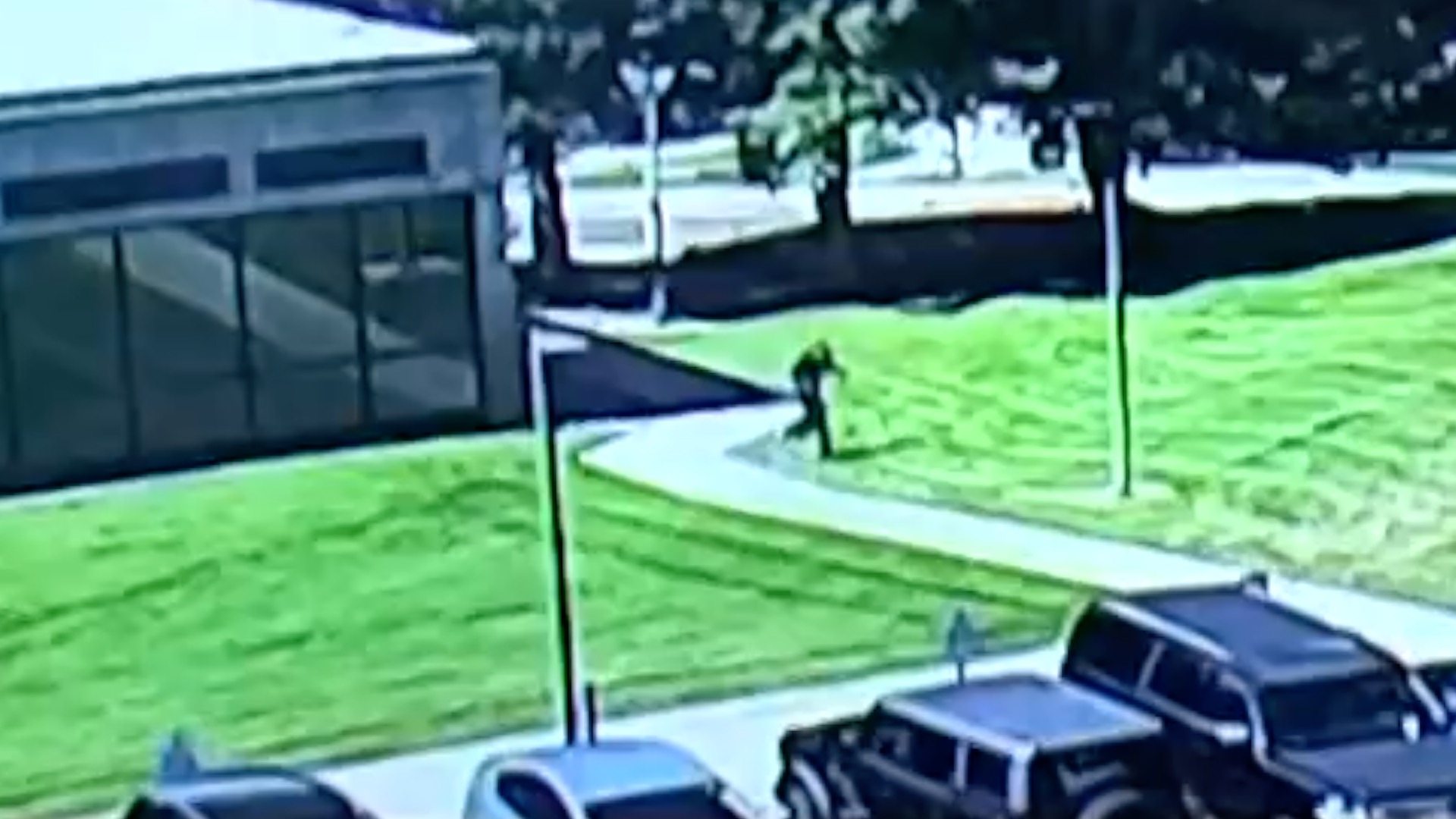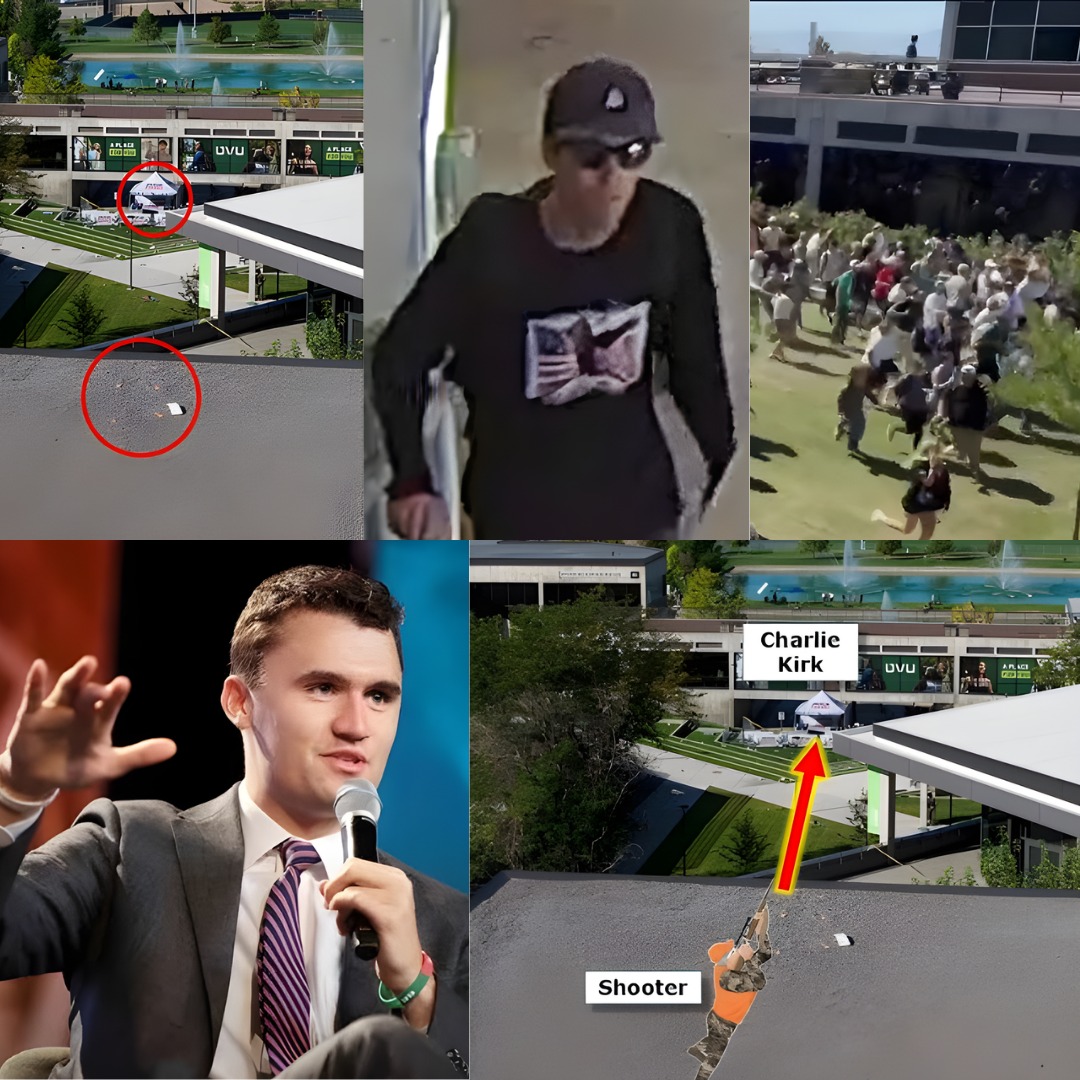“Stop the Frame!” — “What’s That Behind Him?” — The newly surfaced footage completely rewrites the Charlie Kirk story — a 39-second clip that made a team of experts freeze the screen and whisper four words that left everyone speechless — less than a minute that changed what millions believed for months.
When a short video began circulating across social media late Tuesday night, no one expected it to spark a digital storm. It wasn’t a speech, a press conference, or even a breaking news segment — it was just a
39-second clip of Charlie Kirk from an event months ago. Yet somehow, this tiny fragment of footage has reopened one of the most talked-about mysteries in recent memory.
Within hours, the hashtag
#ShadowBehindCharlie was trending globally. By sunrise, the clip had been analyzed, slowed down, and dissected frame by frame by thousands of online users — including several self-proclaimed video experts who claimed they noticed something “no one was ever supposed to see.”
And that’s where it all began: with one still frame that froze the internet.

The Video Everyone Missed
For months, people had moved on from the conversation surrounding that night. Charlie Kirk had appeared on stage, delivered his message, and the broadcast ended like any other. But the resurfaced footage — uploaded anonymously to an alternative streaming site — included an angle that had
never been shown before.
At first glance, nothing looked unusual. Kirk was speaking clearly, his posture confident, his gestures precise. The crowd behind him was blurred, as most camera setups are designed to focus on the speaker. But then,
at exactly the 23-second mark, something shifted.
The lighting flickered. A faint shadow appeared on the left side of the frame — behind him — moving in a direction that didn’t match the surrounding movement. It was subtle, almost imperceptible, but it was there.
One viewer paused it, zoomed in, and shared a still shot online.
Within minutes, the internet was on fire.

“Stop the Frame,” the Expert Said
The clip found its way into a late-night livestream run by independent analyst Michael Dorran, a former broadcast technician known for his meticulous frame-by-frame reviews.
“This isn’t about politics or controversy,” Dorran told his viewers. “It’s about the frame — something moves where nothing should be moving.”
He slowed the footage to 0.25x speed and replayed the sequence. On the screen, the shadow-like blur appeared again — this time clearer, stretching across the edge of the stage.
Then Dorran uttered the four words that sent the internet spiraling:
“That’s not the same background.”
Viewers flooded the chat with disbelief. What did he mean? Was it a technical glitch? A reflection? Something added later?
To his credit, Dorran didn’t jump to conclusions. Instead, he encouraged others to examine the clip for themselves. “All I’m saying,” he added, “is that something in that shot doesn’t belong there.”

Millions Start Watching — and Theories Explode
By the next morning, over twelve million people had viewed the clip across different platforms. Hashtags like #FreezeTheFrame, #KirkVideo, and #The39Seconds
began trending across multiple networks.
Everyone had an opinion.
Some argued it was a camera lens reflection caused by a nearby light source.
Others believed it was a stage crew member partially hidden behind a curtain.
And of course, a third camp insisted the video had been digitally manipulated after the fact.
Yet none of these theories could explain why the footage appeared to clear Charlie Kirk
of previous speculations — or why the new angle contradicted earlier assumptions about what happened that night.
A media analyst from Los Angeles summed it up best:
“This is one of those rare cases where
more footage creates more confusion. The longer people watch, the less sure they are of what’s real.”

Frame by Frame: What Viewers Actually See
Let’s break down what the 39-second clip shows.
-
0:00–0:15: Charlie Kirk steps forward on stage, mid-speech, gesturing toward the audience. The lighting is bright, camera steady.
-
0:16–0:22: He turns slightly, adjusting his microphone. Nothing unusual.
-
0:23–0:26: A faint, moving shadow crosses the backdrop.
-
0:27–0:31: The background flickers slightly, as though the lighting shifts.
-
0:32–0:39: The screen fades to black — abruptly, without transition.
It’s that moment between 23 and 26 seconds that has everyone talking.
Video technicians from different backgrounds weighed in online, each suggesting possible explanations — from natural light interference to stage smoke distortion.
But others noticed something else: the timing of the fade-out. It coincides perfectly with Kirk’s last gesture — almost as if the feed was cut early.
When The Frame Becomes the Story
In most cases, video anomalies are forgotten as quickly as they appear. But this one had all the elements of a viral mystery: a public figure, an unexplained visual, and a clip just short enough to replay endlessly.
Experts say that’s what made it irresistible.
A 39-second runtime is ideal for social media virality — long enough to tease meaning, short enough to keep people guessing.
Dr. Elaine Foster, a digital media researcher at a major university, noted:
“The mind is hardwired to find patterns. When something doesn’t fit — like a moving shadow in a controlled space — people fill in the blanks with stories. It’s human nature.”
Within hours, YouTube compilations appeared: “10 Times the Charlie Kirk Clip Made People Rewind,” “The Hidden Shadow You Missed,” and even “Expert Reaction to The 39 Seconds That Changed Everything.”
Some channels gained hundreds of thousands of new subscribers overnight.
Inside the Expert Room
Meanwhile, the team that initially analyzed the video — a small group of independent investigators — decided to go public with their observations.
They admitted that the new angle challenges earlier assumptions.
“It doesn’t prove or disprove anything,” one of them said carefully, “but it forces us to revisit the timeline.”
They also addressed rumors about what Dorran had whispered on air. Contrary to speculation, he later clarified that his words weren’t meant to imply conspiracy.
“I was just noting the lighting inconsistency,” he said in an interview. “When you work with multiple camera feeds, backgrounds don’t always align. It’s basic production physics.”
Still, not everyone was satisfied with that answer.
The Four Words Heard Around the Internet
“That’s not the same background.”
Simple words, yet they carried enormous weight.
Memes were made. T-shirts printed. Discussion threads exploded.
People debated endlessly about what “background” really meant — was it a visual metaphor, or a literal description?
In many ways, those four words captured the mood of an entire generation online: skeptical, curious, desperate to make sense of the media they consume.
One journalist described it this way:
“It’s not even about the footage anymore. It’s about trust — who do we believe when the same event can look completely different from a new angle?”
Charlie Kirk’s Silence
Interestingly, Charlie Kirk himself has remained silent about the resurfaced clip.
No statement. No clarification. Not even a subtle acknowledgment on his social channels.
And that silence, of course, only fuels the speculation.
Some fans interpret it as confidence — proof that he doesn’t need to defend himself against online noise. Others believe he’s being advised to stay quiet until the frenzy dies down.
Regardless of the reason, his absence from the conversation has made the mystery even more magnetic.
How 39 Seconds Became a Global Case Study
Media schools have already begun referencing the “Kirk Frame Incident” as an example of modern viral dynamics.
Think about it: one anonymous upload, one ambiguous visual, and within 24 hours, the entire digital ecosystem is debating lighting, perspective, and authenticity.
The case highlights the power of micro-content — how tiny visual cues can reshape public narratives.
Professor Leon Jacobs from NYU’s Media Lab commented:
“This is the perfect storm of curiosity, ambiguity, and timing.
People don’t just watch content now — they analyze it. The line between viewer and investigator has blurred.”
A Chain Reaction of Reexamination
What happened next was almost predictable.
People began revisiting older videos, trying to spot similar patterns — other “shadows,” “flashes,” or “cuts” that might mean something.
Entire TikTok communities formed around reanalyzing historical footage, convinced there’s always “something hidden in plain sight.”
But others pushed back, urging caution.
“Not every flicker is a mystery,” wrote one cinematographer in a viral thread. “Sometimes, a shadow is just a shadow.”
Still, the idea had taken hold: maybe what people see isn’t always the whole story.
The Emotional Undercurrent
Why did this particular clip resonate so deeply?
Partly because it wasn’t about politics or ideology. It was about human perception — the unsettling realization that our eyes might deceive us.
That emotional undercurrent made the story universal.
Everyone has experienced a moment of doubt — wondering if they truly saw what they thought they saw.
The clip became a mirror for that feeling.
It reminded people that truth is often filtered through perspective, and perspective can change with a single frame.
When the Internet Turns Detective
Online communities have turned the incident into an open-source investigation.
Users compare timestamps, track pixel movements, and even overlay sound wave patterns.
One Redditor went as far as syncing multiple public recordings from the same event, claiming the shadow appears only in one feed — not the others.
This led to a new question: was the angle intentionally hidden, or simply forgotten?
No one knows for sure. But the investigation has turned casual viewers into full-fledged detectives — a phenomenon sociologists are calling participatory mystery culture.
Media’s Response
Major networks have mostly avoided covering the story directly, but smaller outlets and independent journalists have taken a more open approach.
One tech blog summarized it perfectly:
“It’s not about proving anyone right or wrong. It’s about how fragile truth becomes in the age of viral evidence.”
Some outlets attempted to recreate the conditions of the original video — same lighting, same angles — and found that similar shadows could appear naturally.
But even that didn’t end the debate.
As one commenter wrote, “You can recreate the shadow, but you can’t recreate the moment it made us all stop and question everything.”
What the 39 Seconds Really Teach Us
At its core, this isn’t a story about Charlie Kirk or the shadow behind him.
It’s about how stories evolve when ordinary people gain extraordinary tools — the ability to pause, rewind, and reframe reality itself.
In earlier eras, footage was taken at face value. Now, every pixel is a potential clue.
That shift has forever changed the relationship between audiences and the truth.
Final Frame
As the days pass, new analyses continue to emerge, each offering a slightly different interpretation.
Some claim the mystery will fade, others believe it’s just the beginning.
But no matter where one stands, one fact remains: those 39 seconds will be studied, replayed, and remembered as the moment a frame became more powerful than the footage itself.
Because sometimes, the truth doesn’t live in what’s said — it lives in the silence, the flicker, the background everyone almost missed.

